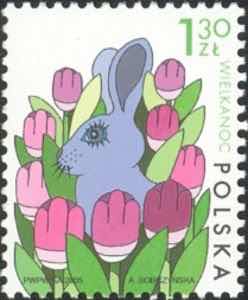Beautiful envelopes with so many Easter eggs and symbols of Easter on stamps from Poland 🇵🇱
Poland has been issuing stamps for Easter for the past 10-12 years
Easter 2016

Easter 2014
 I
I

Easter 2019

Easter 2007

Easter 2014
Easter 2014
Thanks Wojtek for these beautiful covers with Easter stamps :)
Polish pisanka (Easter eggs) is a common name for an egg (usually that of a chicken, although goose or duck eggs are also used) richly ornamented using various techniques. The word pisanka is derived from the verb 'pisać' which in contemporary Polish means exclusively 'to write' yet in old Polish meant also 'to paint'. Originating as a pagan tradition, pisanki were absorbed by Christianity to become the traditional Easter egg. Pisanki are now considered to symbolise the revival of nature and the hope that Christians gain from faith in the resurrection of Jesus Christ.
Kraszanki are made by boiling an egg in a decoction of plants or other natural products.
Drapanki or skrobanki are made by scratching the surface of a kraszanka with a sharp tool to reveal the white of the egg shell.
Pacenka are created by drawing or painting.
Traditional technique requires the egg shell to be covered with a layer of molten wax in which the pattern is scratched.
Naklejanki or nalepianki are decorated with petals of elderberry, scraps of colourful paper(including wycinanki) or with patches of cloth.
Malowanki - These eggs are decorated with paints, very often on natural (undyed) eggshells.
Oklejanki or wyklejanki are decorated with bulrush pith or yarn.
Dzierganki - Those are eggs covered in tight knitted ‘pouches’, sometimes with elements like lace or bows as well.
Azurki- This is a modern technique of creating perforated eggs, made from wydmuszki(emptied eggshells).
On the Polish lands, the oldest decorated eggs discovered so far come from the 10th century. They were unearthed during the archaeological excavations in Ostrówek(near the city of Opole) where remnants of a Slavic settlement from the early Piast Dynasty era.
The word ‘pisanki’ is derived from the verb pisać – to write.
Orthodox and Eastern Catholic churches believe the hard shell of the egg symbolizes the sealed "Tomb of Christ" and its cracking represents his resurrection from the dead.
Ritual of ‘writing’ on the eggs was performed strictly during the times of fasting (Lents) before Easter. In many regions of Poland it was a custom reserved for women (if a man entered the room by accident, he’d be rushed out and a ritual of ‘purification’ of the room with salt was performed). Pisanki could’ve been prepared as early as 3-4 weeks before the Easter on wydmuszki (emptied eggshells), but no later than on the day of the Holy Friday. The motifs painted on pisanki have a deep symbolic meaning, connected to rebirth, fertility, beauty, protection, and sun symbolism (vitality). Pisanki are then added into special Easter baskets along with other symbolic food products, and blessed on the Holy Saturday in churches. These food baskets are called święconki.
Pisanki made fresh out of the boiled eggs are later eaten on the Easter Sunday during the main Easter breakfast. They are divided into small portions and shared around the table with all the people present by the Easter table. The blessed food products are remnants of ‘pagan’ Slavic food offerings for the spring, syncretized over the centuries with the celebrations of Easter. Before the dominance of the Christianity in Poland, the eggs were decorated for the spring equinox: Slavic feast called Jare Gody. The original background of the custom is almost forgotten nowadays.
Many other Central and Eastern European ethnic groups decorate eggs using wax resist for Easter. These include the
Belarusians(пісанка, pisanka),
Bulgarians (писано яйце, pisano yaytse),
Carpatho-Rusyns (крашанкы, krašankŷ, or писанкы, pysankŷ),
Russian (крашанки, krashanki, or писанки, pisanki),
Croats (pisanica),
Czechs (kraslice),
Hungarians (hímestojás),
Lithuanians(margutis),
Poles (pisanka),
Romanians (ouă vopsite, încondeiate or împistrite),
Serbs(pisanica),
Slovaks (kraslica),
Slovenes (pirhi, pisanice, or remenke) and
Sorbs (jejka pisać).
I find the tradition of Easter eggs very interesting. It’s a way of spending the Lent days for a purpose - for the purpose of Hope - for a great spring and also for developing faith in one’s heart.
Postcards with Easter greetings from Wojtek and Waldek
And just like Christmas markets , Poland also has Easter markets and they offer postmarks on envelopes as well :)
postmark showing a lamb made of
In Bible, Jesus is often referred as the "Lamb of God". A significant symbol of Easter, a lamb symbolises Jesus' sacrifice for the mankind. Traditionally, the Pope and many Christians across the world eat roast lamb on Easter Sunday. On a less symbolic note, lamb would have been one of the first fresh meats available after a long winter with no livestock to slaughter.
Thanks Wojtek and Waldek for giving me a snapshot of the beautiful Easter tradition in Poland ! I wonder how your Easter eggs looked like :)
A collage of the scene in the market square on Easter Sunday in Kraków 2019 !
So beautiful ! And I am really happy to see my cover in the midst of such joyous activities :)
No comments:
Post a Comment